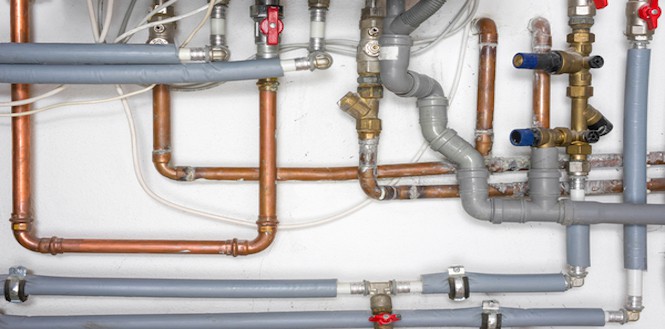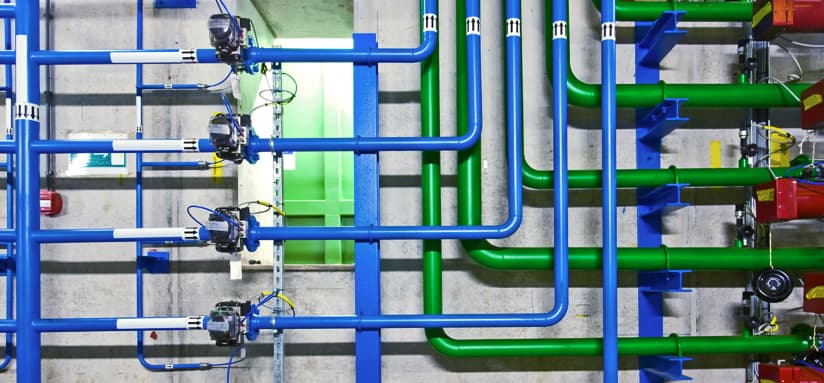Examining Your Property's Plumbing System Anatomy
Examining Your Property's Plumbing System Anatomy
Blog Article
We've unearthed this post relating to Understanding Your Home's Plumbing Anatomy down the page on the internet and reckoned it made good sense to discuss it with you here.

Recognizing how your home's pipes system works is crucial for every homeowner. From delivering tidy water for alcohol consumption, food preparation, and showering to safely eliminating wastewater, a well-kept pipes system is crucial for your family members's health and convenience. In this detailed overview, we'll check out the detailed network that comprises your home's pipes and offer suggestions on maintenance, upgrades, and managing typical problems.
Intro
Your home's pipes system is greater than simply a network of pipes; it's a complex system that ensures you have access to clean water and efficient wastewater elimination. Recognizing its parts and how they collaborate can help you protect against pricey repair work and ensure everything runs efficiently.
Fundamental Parts of a Plumbing System
Pipelines and Tubes
At the heart of your plumbing system are the pipelines and tubing that carry water throughout your home. These can be made from different materials such as copper, PVC, or PEX, each with its advantages in regards to durability and cost-effectiveness.
Fixtures: Sinks, Toilets, Showers, and so on.
Components like sinks, commodes, showers, and tubs are where water is used in your home. Recognizing exactly how these fixtures connect to the pipes system assists in diagnosing problems and preparing upgrades.
Shutoffs and Shut-off Points
Valves control the circulation of water in your pipes system. Shut-off shutoffs are important throughout emergency situations or when you need to make fixings, enabling you to separate parts of the system without disrupting water circulation to the entire house.
Water System System
Key Water Line
The primary water line connects your home to the metropolitan water supply or a personal well. It's where water enters your home and is dispersed to various components.
Water Meter and Pressure Regulatory Authority
The water meter procedures your water usage, while a stress regulator makes sure that water streams at a risk-free pressure throughout your home's pipes system, preventing damage to pipelines and fixtures.
Cold Water vs. Hot Water Lines
Recognizing the distinction between cold water lines, which supply water straight from the main, and warm water lines, which bring heated water from the hot water heater, assists in troubleshooting and planning for upgrades.
Drainage System
Drain Pipes and Traps
Drain pipes carry wastewater far from sinks, showers, and bathrooms to the sewer or sewage-disposal tank. Traps protect against sewage system gases from entering your home and also trap debris that might trigger blockages.
Ventilation Pipelines
Ventilation pipes enable air into the water drainage system, preventing suction that could slow drain and cause traps to empty. Appropriate air flow is important for maintaining the honesty of your pipes system.
Importance of Proper Water Drainage
Ensuring appropriate drain avoids back-ups and water damages. Regularly cleansing drains and maintaining traps can avoid costly fixings and extend the life of your pipes system.
Water Heating Unit
Types of Water Heaters
Water heaters can be tankless or traditional tank-style. Tankless heaters heat water as needed, while tanks keep warmed water for instant usage.
How Water Heaters Link to the Pipes System
Recognizing exactly how water heaters link to both the cold water supply and hot water circulation lines helps in detecting issues like not enough warm water or leakages.
Upkeep Tips for Water Heaters
On a regular basis purging your hot water heater to eliminate sediment, inspecting the temperature settings, and evaluating for leakages can prolong its life expectancy and enhance power effectiveness.
Usual Plumbing Concerns
Leakages and Their Causes
Leakages can occur due to maturing pipes, loose installations, or high water stress. Dealing with leakages quickly avoids water damages and mold development.
Blockages and Obstructions
Blockages in drains and toilets are typically triggered by purging non-flushable products or a buildup of grease and hair. Making use of drain screens and bearing in mind what goes down your drains can protect against blockages.
Signs of Plumbing Troubles to Look For
Low tide stress, sluggish drains, foul odors, or uncommonly high water costs are signs of possible plumbing troubles that ought to be addressed without delay.
Pipes Maintenance Tips
Normal Assessments and Checks
Schedule annual pipes evaluations to capture concerns early. Try to find signs of leakages, rust, or mineral accumulation in taps and showerheads.
DIY Upkeep Tasks
Basic jobs like cleaning tap aerators, checking for commode leaks utilizing color tablets, or shielding exposed pipelines in cold environments can stop significant plumbing problems.
When to Call a Specialist Plumbing Technician
Know when a plumbing problem requires expert know-how. Attempting complicated repairs without appropriate expertise can lead to more damages and greater repair costs.
Upgrading Your Pipes System
Reasons for Upgrading
Updating to water-efficient fixtures or replacing old pipelines can boost water quality, lower water bills, and enhance the worth of your home.
Modern Pipes Technologies and Their Advantages
Check out innovations like smart leakage detectors, water-saving bathrooms, and energy-efficient water heaters that can conserve money and minimize ecological influence.
Expense Considerations and ROI
Determine the ahead of time costs versus lasting cost savings when considering pipes upgrades. Several upgrades pay for themselves with lowered energy expenses and less repairs.
Ecological Impact and Conservation
Water-Saving Fixtures and Appliances
Mounting low-flow taps, showerheads, and toilets can substantially lower water use without giving up performance.
Tips for Minimizing Water Usage
Basic behaviors like fixing leakages without delay, taking shorter showers, and running complete tons of laundry and dishes can preserve water and reduced your energy bills.
Eco-Friendly Plumbing Options
Take into consideration lasting pipes materials like bamboo for flooring, which is durable and eco-friendly, or recycled glass for countertops.
Emergency Preparedness
Actions to Take Throughout a Plumbing Emergency
Know where your shut-off shutoffs lie and just how to shut off the supply of water in case of a burst pipeline or major leak.
Importance of Having Emergency Calls Helpful
Keep contact details for regional plumbing technicians or emergency services conveniently offered for quick reaction during a pipes crisis.
DIY Emergency Fixes (When Suitable).
Short-lived solutions like making use of duct tape to spot a leaking pipeline or putting a bucket under a trickling faucet can decrease damage up until an expert plumbing gets here.
Conclusion.
Understanding the makeup of your home's plumbing system empowers you to maintain it successfully, conserving time and money on repairs. By complying with regular maintenance regimens and staying notified regarding modern-day plumbing technologies, you can guarantee your plumbing system runs effectively for many years ahead.
HOW YOUR PLUMBING SYSTEM WORKS
Which Pipes Do What?
Blue lines = fresh water supply entering the building
Red lines = hot water supply entering the building
Grey lines = pipes carrying waste away from the building and venting pipes carrying gases away from the building (through the roof)
YOUR MAIN PLUMBING SYSTEMS
There are two main plumbing systems that support your home s basic plumbing needs one that brings clean water into your home, and one that sends dirty water away from your home. Connected to the toilet, bath, shower, and other faucets in your home, these two systems keep your water flowing in the right directions.
ACCESSING FRESH WATER
Fresh and clean water is brought into your home through the main water supply line . Filtered through one pipe, this water is pressured to flow into the various fixtures in your home at any given time.
This water can be sourced from a well located on your property, a pond or river (mostly cottages), or, as in most cases, from the city s municipal water treatment centre. However, it is important to note that water that is untreated, such as the water siphoned from ponds or rivers, may not be safe to drink. Personal water supplies always need to be treated for hardness and contaminants before consumed.
MUNICIPAL WATER SUPPLIES
Improve taste and odour
Remove sediment
Eliminate hardness
Reduce chlorine
COLD WATER SUPPLY VS. HOT WATER SUPPLY
Cold water flows into your home or building through the service line, which then distributes hot or cold water to your fixtures. This line is most commonly run through a central column that runs floor to floor. Hot water runs in short and straight pipes as the longer the pipeline, the more heat that will be lost in the transfer. Having shorter pipes also allows residents to access hot water more quickly.
WASTE WATER SYSTEM
Your wastewater system is divided into two parts pipes that send wastewater away from your home and venting pipes that send sewer gas away from your home. Sewage water travels through pipes that flush the water and waste towards local sewers that are operated and managed by your city or town. Most sewer systems rely on gravity to move the wastewater to where it needs to go.
The further away from your toilet or sink, the larger wastewater pipes become. This allows for waste to be disposed of from various parts of your home or business at once without pipe blockages. The angle and flow of these pipes are also essential for keeping your waste pipes clear of build up.
https://harrisplumbing.ca/how-your-home-plumbing-system-works/

HOW YOUR PLUMBING SYSTEM WORKS
Which Pipes Do What?
YOUR MAIN PLUMBING SYSTEMS
There are two main plumbing systems that support your home s basic plumbing needs one that brings clean water into your home, and one that sends dirty water away from your home. Connected to the toilet, bath, shower, and other faucets in your home, these two systems keep your water flowing in the right directions.
ACCESSING FRESH WATER
Fresh and clean water is brought into your home through the main water supply line . Filtered through one pipe, this water is pressured to flow into the various fixtures in your home at any given time.
This water can be sourced from a well located on your property, a pond or river (mostly cottages), or, as in most cases, from the city s municipal water treatment centre. However, it is important to note that water that is untreated, such as the water siphoned from ponds or rivers, may not be safe to drink. Personal water supplies always need to be treated for hardness and contaminants before consumed.
MUNICIPAL WATER SUPPLIES
COLD WATER SUPPLY VS. HOT WATER SUPPLY
Cold water flows into your home or building through the service line, which then distributes hot or cold water to your fixtures. This line is most commonly run through a central column that runs floor to floor. Hot water runs in short and straight pipes as the longer the pipeline, the more heat that will be lost in the transfer. Having shorter pipes also allows residents to access hot water more quickly.
WASTE WATER SYSTEM
Your wastewater system is divided into two parts pipes that send wastewater away from your home and venting pipes that send sewer gas away from your home. Sewage water travels through pipes that flush the water and waste towards local sewers that are operated and managed by your city or town. Most sewer systems rely on gravity to move the wastewater to where it needs to go.
The further away from your toilet or sink, the larger wastewater pipes become. This allows for waste to be disposed of from various parts of your home or business at once without pipe blockages. The angle and flow of these pipes are also essential for keeping your waste pipes clear of build up.
https://harrisplumbing.ca/how-your-home-plumbing-system-works/
Do you really like reading up on Plumbing Installation 101: All You Need to Know? Place feedback below. We'd be pleased to find out your opinion about this content. Hoping that you come back again before long. Sharing is nice. You just don't know, you may be doing someone a favor. Thank you so much for your time invested reading it.
Automated Marketing Report this page